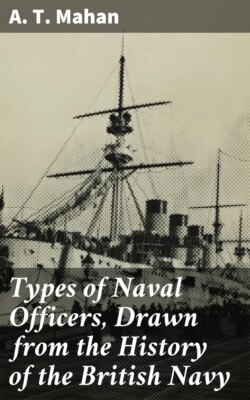Types of Naval Officers, Drawn from the History of the British Navy

Реклама. ООО «ЛитРес», ИНН: 7719571260.
Оглавление
A. T. Mahan. Types of Naval Officers, Drawn from the History of the British Navy
Types of Naval Officers, Drawn from the History of the British Navy
Table of Contents
PREFACE
ILLUSTRATIONS
TYPES OF NAVAL OFFICERS
INTRODUCTORY
Naval Warfare at the Beginning of the Eighteenth Century
FOOTNOTES:
HAWKE
1705–1781
FOOTNOTES:
RODNEY
1719–1792
FOOTNOTES:
HOWE
1726–1799
FOOTNOTES:
JERVIS
1735–1823
FOOTNOTE:
SAUMAREZ
1757–1836
PELLEW
1757–1833
FOOTNOTES:
Index
Отрывок из книги
A. T. Mahan
Published by Good Press, 2019
.....
The thing to be observed here is the separate, but positive, initiative prescribed for a portion of the fleet, with a view to divide the enemy, and then concentrate the whole fleet upon the fraction thus isolated. The British van takes a particular, but not an independent, action; for the other divisions contribute their part to the common purpose. "The middle squadron is to keep her wind, and to observe the motion of the enemy's van, which" [that is, "which" action of the middle squadron] "the last squadron—the rear—is to second; and both of these squadrons are to do their utmost to assist or relieve the first squadron, that divided the enemy's fleet." Evidently here we have tactical combination in order to decisive action; clearly contemplated also beforehand, not merely by a capable individual general, but by the consensus of professional opinion which such a paper as the Fighting Instructions necessarily reflects. The stamp of the galley period is upon this: strenuous and close battle, the piercing of the enemy's order, the movement of the squadrons differentiated, in order that they may in a real and effective sense combine, instead of being merely distributed, as they afterwards were by both the letter of the later Instructions and the tradition by which these became encrusted. Nor should there be overlooked, in this connection, the discretion allowed the centre and rear. They are to "keep their wind;" an expression which leaves optional whether to tack, or stand as they are, whether to engage the separated enemies to windward or to leeward, as occasion may offer, in support of the van. The provisions of 1665 afterwards disappear. In 1740, and even as late as 1781, they are traceable only in certain colorless articles, suggestive of the atrophied organs of a body concerning whose past use physiologists may speculate.
As in the restoration of sounder methods, with which we shall be concerned, this degeneration of ideals was a work of time. In June, 1666, the British met with a severe check in the Four Days Battle, in which Monk, a soldier, commanded in chief. This reverse is chiefly to be attributed to antecedent strategic errors, which made a portion only of the available British force bear the brunt of the first three days; but, among the inevitable criticisms, we find stress laid upon fighting in line as essential to success. This insistence upon the line as an effective instrument proceeded, among others, from Sir William Penn, a seaman, and was at that time in the direction of professional advance. The line had not yet obtained the general professional acceptance needed to establish and utilize its indisputable value. This process was gradual, but when effected it followed the usual laws of human development; from a valuable means, it became in men's estimation an exaggerated necessity. It came to pass in time that the line no longer existed for tactics, but tactics for the line, in which they found their consummation and end.
.....